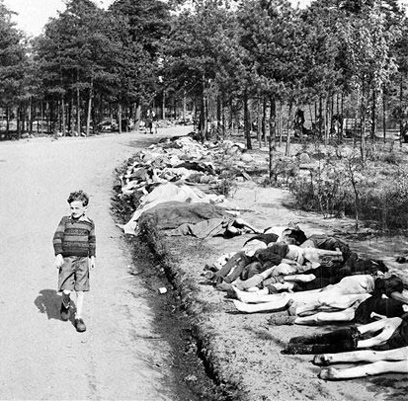
Study reveals scope of female murderers in Holocaust
Researcher tells New York Times women of Third Reich reached as far as occupied Poland, Ukraine to take part in 'Final Solution'
Amid the horrors of the Holocaust, the names of women who took part in the Nazi death machine have always stood out as aberrations of nature. The vicious actions of a few of them have managed to leave their names deeply burned in the world's consciousness decades later.
Such women include the notorious Ilse Koch, wife of Majdanek concentration camp commandant Karl Koch, who was known for her sadistic abuse of her victims, and Irma Grese, the SS woman whose actions gained her the title "the beast of Belsen" for the brutality she employed at the Bergen-Belsen concentration camp.
The fact that female participation in committing the horrendous acts was relatively low created the perception that the Holocaust was almost exclusively a male-dominated affair. But a new study which was published in the New York Times revealed that despite this assumption, German women played a much greater role in the extermination of Jews than previously believed – and not just as passive witnesses or accomplices, but also as direct perpetrators.
The study was conducted by American historian Wendy Lower, who currently resides in Munich. Lower drew attention to the activity of seemingly "ordinary" German women who willingly moved to the eastern territories occupied by the Third Reich, where most of the Jewish genocide was taking place, from the start of the implementation of the "Final Solution" to Nazi Germany's fall and the end of World War II.
Operated on own initiative
In an interview with the New York Times that took place in Jerusalem, Lower addressed the number of women involved, saying, “Thousands would be a conservative estimate.”
While most of them did not bloody their own hands, those who did seemed even more perverse because they chose to operate outside the concentration camps and of their own initiative. Experts believe Lower's research from a gender perspective shed a whole new light on the role of the lower echelons in the Nazi killing machine.

Bodies at Bergen-Belsen (Photo: AP)
“In the dominant literature on perpetrators, you won’t find women mentioned,” said Dan Michman, the chief historian at Yad Vashem, the Holocaust Martyrs’ and Heroes’ Remembrance Authority in Jerusalem.
The 45-year-old Lower first presented her work at Yad Vashem's International Institute for Holocaust research, and tried to pinpoint the women's motivation to take an active part in the ruthless acts of killing.
“They challenge so deeply our notion” of what constitutes normal female behavior, she said. But the Nazi system, she added, “turned everything on its head.”
Lower worked at the Holocaust Memorial Museum in Washington for many years, and is now teaching and researching at Ludwig-Maximilians-Universitat in Munich. In 1990, which the fall of the Iron Curtain and the opening of Soviet archives, which had been closed for decades, Lower traveled to Ukraine for her research. She began her journey in the city of Zhytomyr, where the SS leader Heinrich Himmler had his Ukrainian headquarters.
There, she managed to locate in the archives original Nazi documents, some burned at the edges. Lower could not ignore the frequency with which women were mentioned at the scenes of genocide.
Many women also kept coming up as witnesses in the Nazi criminal investigations held in East and West Germany in the years following the war.
The issue was first addressed in a 1992 book entitled "Ordinary Men," by Christopher R. Browning. The book estimated that thousands of German women joined the efforts to annex the eastern territories occupied by the Third Reich, and provided services to the local German minorities there.
The women included nurses, teachers and welfare workers. The warehouses where confiscated Jewish property was stored were run by women, and the women that lived in the east were recruited to work as interpreters. The women also included the wives of regional officials and their secretaries.
The occupied zones offered an attractive opportunity for many women from working-class or farming families to advance themselves, Lower explained.
According to her study, about 5,000 women served as guards at concentration camps, and made up about 10% of the overall personnel.
Browning's book documents the role of German Reserve Police Battalion 101, which provided the manpower for eliminating Poland's Jews within less than a year.

Children's head smashed against ghetto wall (Archive photo: AFP)
The book also makes mention of the wife of one of the battalion's captains, who traveled to Poland while she was pregnant. There, while millions of Jews were being sent to the gas chambers, she celebrated a kind of honeymoon with her husband and observed as he "cleansed" the ghetto of Jews.
Lower stressed that the number of women who took part in the Nazi crimes did not exceed 2%, but she noted that many other women witnessed or were close to the extermination sites. Several witnesses even described festive banquets held near mass shooting sites across Ukraine, with German women providing refreshments for the shooting squad whose work would go on for days.
Murdered children to prove herself
The New York Times report also related the story of Erna Petri, the wife of SS officer who ran an agricultural estate, with slave laborers, in Galicia, in occupied Poland.
After the war she confessed to murdering no less than six Jewish children, aged six to 12, who she came across while riding in her carriage. At the time Petri was only 25-years-old, and a mother of two young children. She noticed the Jewish children running almost naked, after apparently escaping a train headed for the Sobibor death camp. Petri took the children home, fed them, and then led them into the forest, were she shot them dead one by one.
In her interrogation, Petri said one of the reasons she murdered the children was because she wanted to prove herself to the men. She was tried in East Germany and served a life sentence.
Another female Nazi, Johanna Altvater Zelle was 22 when she arrived in occupied Ukraine as the secretary of a district commissioner, Wilhelm Westerheide. Survivors remember her mainly as "Fraulein Hanna", who was behind the smashing of toddlers' heads against the ghetto wall and throwing Jewish children to their deaths from the window of a makeshift hospital.
Upon her return to Germany, Altvater Zelle became a welfare worker for youth in her hometown and even adopted a son. In the region under her commissioner's control, some 20,000 Jewish were wiped out. Westerheide and his secretary were tried twice in West Germany, but were acquitted both times because of contradictions in testimonies of witnesses collected over 20 years.
One survivor, Moshe Messer, witnessed Altvater Zelle's atrocities in person, and described her actions to his lawyer in the 1960s, saying, “Such sadism from a woman I have never seen. I will never forget this scene.”
- Follow Ynetnews on Facebook










